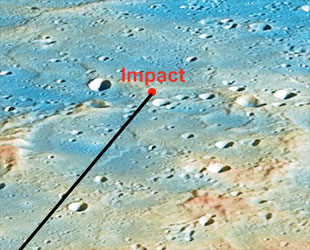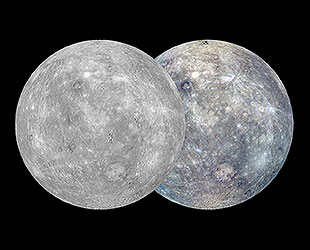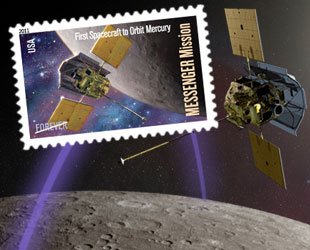April 30, 2015 — The first spacecraft to orbit Mercury, the planet closest to the Sun, is no more.
On Thursday (April 30), NASA's MErcury Surface, Space ENvironment, GEochemistry and Ranging (MESSENGER) spacecraft impacted the small planet at more than 8,750 miles per hour (14,080 kilometers per hour). The probe hit the planet at about 3:26 p.m. EDT (1926 GMT) on the side facing away from the Earth, leaving a crater about 52 feet (16 meters) across, based on pre-impact estimates.
The collision came as a result of MESSENGER depleting its propellant after almost 11 years. Mission controllers at the Johns Hopkins University Applied Physics Laboratory in Maryland, exhausted the last of the craft's reserves with an orbit correction maneuver last Friday (April 24).

Graphic showing the best prediction of MESSENGER's impact on Mercury's surface, as of a day before. (NASA/JHU APL/Carnegie) |
"The maneuver will deplete nearly all our remaining helium gas," Daniel O'Shaughnessy, APL systems engineer, said earlier this month, while previewing the end of the mission. "At that point, the spacecraft will no longer be capable of fighting the downward push of the sun's gravity."
Launched Aug. 3, 2004, MESSENGER flew by the Earth once, Venus twice and Mercury three times before finally entering orbit on March 18, 2011. After completing its first year mapping the planet, the MESSENGER mission was extended twice, lasting to this year.
Although Mercury is one of Earth's nearest neighbors, little was known about the planet prior to MESSENGER. Only one other craft, NASA's Mariner 10, visited Mercury, flying by the planet three times between March 1974 and March 1975.
"For the first time in history we now have real knowledge about the planet Mercury that shows it to be a fascinating world," John Grunsfeld, NASA associate administrator for science, said. "We are celebrating MESSENGER as more than a successful mission."

Global maps of Mercury based on the data collected by NASA's MESSENGER mission as of 2013. (NASA/JHU APL/Carnegie) |
One of MESSENGER's key findings provided compelling support for the hypothesis that Mercury harbors abundant frozen water and other volatile materials in its permanently shadowed polar craters.
Data indicated the ice in Mercury's polar regions, if spread over an area the size of Washington, D.C., would be more than two miles (3.2 km) thick. A dark layer covering most of the water ice deposits supports the theory that organic compounds as well as water were delivered from the outer solar system to the inner planets, which may have led to prebiotic chemical synthesis and, thusly, life on Earth.
"The water now stored in ice deposits in the permanently shadowed floors of impact craters at Mercury's poles most likely was delivered by the impacts of comets and volatile-rich asteroids," said Sean Solomon, principal investigator for the mission. "Those same impacts also likely delivered the dark organic material."
In addition to science discoveries, the mission provided technological firsts, including the development of a heat-resistant and highly reflective ceramic cloth sunshade that isolated the spacecraft's instruments and electronics from direct solar radiation – vital to the mission's success given Mercury's proximity to the sun.

The U.S. Postal Service on May 4, 2011 issued a postage stamp celebrating the first spacecraft to orbit Mercury. (USPS/NASA) |
"The front side of the sunshade experienced temperatures in excess of 570° Fahrenheit (300° Celsius), whereas the majority of components in its shadow operated near room temperature," project manager Helene Winters said. "This technology to protect the spacecraft's instruments was a key to the mission success during its prime and extended operations."
During its four years at Mercury, MESSENGER completed 4,104 orbits about the planet.
